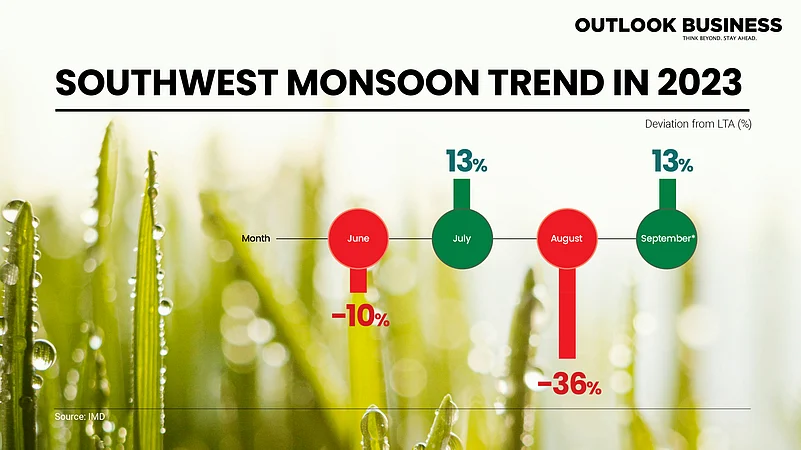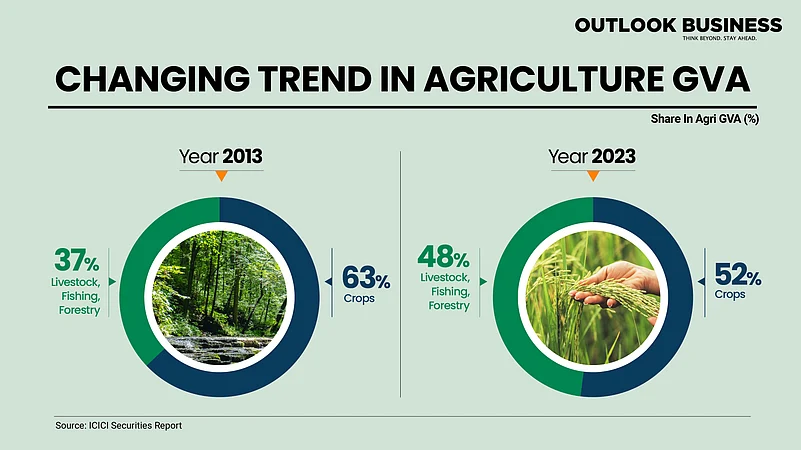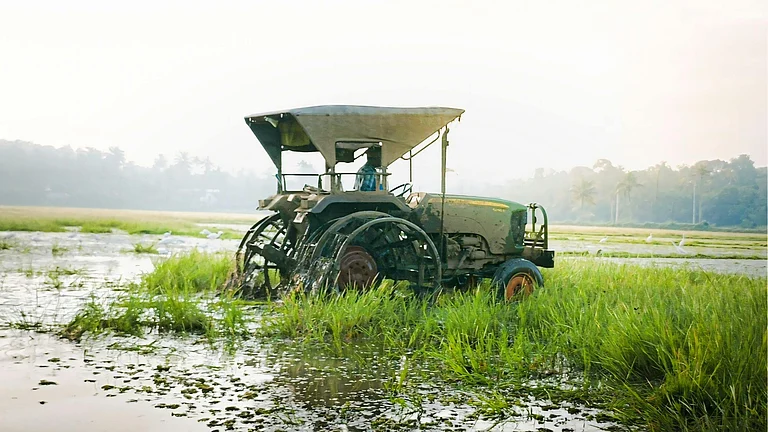Etched in popular memory, the story of Lagaan where the villagers of Champaner suffered the brunt of deficient rainfall. The song ‘Barso re Megha’ encapsulated the dependence on Indian monsoon for the agriculture-dependent residents of the village. The superhit Aamir Khan-led movie was able to tell the story of an important trend in Indian economy: the dependence of agriculture on the southwest monsoon.
Before the monsoon even began in 2023, fears over deficient rainfall took over due to the prediction of El Nino effect. The climatic phenomenon, which refers to heating of Pacific Ocean near the coast of Peru, has led to deficient rainfall in India previously. After the conclusion of Southwest Monsoon, data showed that India recorded below normal monsoon at 94 per cent of long term average (LTA). Due to good rainfalls in September, the monsoon somewhat recovered after a poor August.

As per the IMD data, the deficiency in Monsoon in August stood at 36 per cent of LTA. The rainfall pattern in the country has been erratic this year. In June, the monsoon started with a delay followed by excess rains in July. Looking at the data region wise for August, there is a huge difference in the amount of rain received. While the south peninsula’s deviation from LTA stood at -60 per cent, east India received 2 per cent more rains than the LTA.
Post the conclusion of monsoon, the data showed that kharif sowing has been 0.2 per cent higher than last year due to robust paddy sowing. However, the sowing of pulses and oilseeds has seen decline of -4.2 and -1.61 per cent.
The erratic pattern of rainfall and the uncertainty over monsoon this year has brought the attention back on the need to reduce dependence on the southwest monsoon. Primarily responsible for irrigating agricultural fields and recharging groundwater, experts insist that more needs to be done to ensure a resilient Indian agriculture ecosystem.
Patchy Irrigation
RBI in its August 2023 bulletin noted that the dependency of Indian agriculture has reduced over the years. It said, “With increasing irrigation facilities both in terms of quantity and reach, and adoption of water-efficient irrigation techniques, the dependency of Indian agriculture on monsoon rainfalls is reducing.” As per the data available on the Ministry of Agriculture’s website, around 57 per cent of total agriculture land used for foodgrains was irrigated as of March 2020. As per World Bank data, around 42.3 per cent of total agricultural land was irrigated as of 2021.

Avinash Kishore, Senior Research Fellow at International Food Policy Research Institute, agrees with the observation made by RBI in its bulletin. He says, “It is definitely true that the dependence has somewhat reduced due to improvement in irrigation infrastructure. As compared to the impact of deficient rainfalls in the past, we are seeing a more resilient agriculture ecosystem.”
However, Kishore adds that the access to irrigation isn’t the same for all regions. According to the ministry data, the penetration of irrigation varies significantly across the country. For example, Punjab has over 98 per cent coverage under irrigation while it stood at 10 per cent for Jharkhand. States like Maharashtra and Karnataka also have poor records when it comes to irrigation, with 19.09 and 27.40 per cent coverage respectively till March 2020. It is pertinent to note that around 40 per cent of area under foodgrains farming is still dependent on rains, which are becoming more erratic.

As per the list of major foodgrain producing states available on Agriculture Ministry's website, nine out of 20 states had less than 50 per cent coverage of irrigation as of FY20.
As a result of low irrigation coverage, the farmers in these regions mostly depend on rain to irrigate their fields which leaves them vulnerable. RBI also noted in its bulletin that better irrigation allows states to reduce dependence on southwest monsoon rainfalls. It noted, “Rice production recorded expansion during large number of rainfall deficient times in many states with high coverage of irrigation.”
The trend seems to be playing out this year as well. Looking at the data compiled by analysts at ICICI securities, area sown under rice increased by 16 per cent till September 15 in Bihar despite deficient rainfall of 29 per cent of LTA. The state had over 75 per cent coverage under irrigation as of March 2020.
Lakhwinder Singh Gill, visiting Professor of Economics at Institute for Human Development (IHD), says that there is a need for irrigation expansion for sustainable livelihood of the population dependent on agriculture. “It is pertinent to add conservation of rainwater and using it in the lean period for irrigation is important for the good health of agriculture.” However, there have been questions over whether the expansion of irrigation has progressed at a good pace and whether it is the only answer going forward or there are other steps that need to be taken to improve the resilience of Indian agriculture.
Choice For Resilience
Dr Kaustav Banerjee, Associate Professor at Ambedkar University, argues that instead of focusing on expanding the irrigation infrastructure in the country, more attention needs to be paid towards crop diversification. “The incentive structure in the agri economy has been mostly aligned with the goals of green revolution. However, as the country has now become a food secure, we need to change our approach and move towards less water intensive crops. We need to completely rethink our agriculture’s economic model.” He also adds that the government data on irrigated area isn’t capturing the entire picture. “Many small farmers in highly irrigated area don’t have proper access to irrigation which leaves them vulnerable.”

A recent report by ICICI Security analysts suggests that there is some change in the type of crops being produced in the country. It noted that the share of Livestock, fishing, forestry and horticulture has been rising in the gross value add of agriculture. As per the data, the contribution of crops in agri GVA has reduced from 63 per cent to 52 per cent in the last one decade while the contribution of livestock, fishing and forestry has increased to 48 per cent. Within crops, the analysts noted that horticulture has become the largest category by contributing 28 per cent to the GVA while share of cereals declined to 27 per cent.
However, Kishore opines that changing the choice of staples for the population is not going to be an easy task which hinders the diversification bid. The government of India has been pushing for the promotion of millets in the last one year. Commenting on this, he says, “The yield of millets is comparatively low. It doesn’t have enough incentives for farmers to invest in producing the crop.”
According to Kishore, the key choice in the coming years would be focusing on water control with different approaches for various states. “ Eastern India punches way below its weight in terms of production given the amount of rainfall and the fertile soil they have. So effective water utilisation through proper irrigation can help in this area.” He adds that the government needs to focus a lot on regions which are deprived of irrigation and make sure that allocation under schemes like Pradhan Mantri Krishee Sinchai Yojana is channeled towards these regions.
PMKSY was started in 2015 under the Modi government and it has been extended till 2026 with over Rs 93,000 crore outlay to increase the coverage of irrigation in the country. The scheme has four major components, Accelerated Irrigation Benefit Programme (AIBP), Har Khet Ko Pani (HKKP), Watershed Development component (WDC) and Per Drop More Crop (PDMC) component. It is implemented along with state governments.
As per the data available on PMKSY-AIBP dashboard, around 45 per cent of targeted projects were completed as of August 31. In a press release on PDMC component in July, the government noted, “An area of 78 lakh ha has been covered under Micro Irrigation from 2015-16 to till date which is about 81 per cent more than the area covered during pre-PDMC 8 year.” In a status report in July, the government had revealed that most of the projects targeted under WDC were completed, while over 370,000 hectares of surface minor irrigation was added under HKKP till FY23. Notably, PDMC was in spotlight in June when an Indian Express investigation revealed huge discrepancies, showing that of the 94 beneficiaries tracked by the paper, only 17 had actually received benefits.
Overall, between 2015 and 2020, foodgrains area under irrigation increased from 53.01 per cent to 56.96 per cent. Gill says that the pace of investment by state and central governments in expanding the infrastructure of irrigation has been slow and there is still huge scope of expansion. He cautions that the climate changes have dramatically altered the monsoon pattern and there is a high risk of crop failures. He adds, “A heavily populated country like India does not have a tradeoff to either develop irrigation infrastructure or develop water saving crop technologies. India cannot wait but to make heavy investment both in developing irrigation infrastructure, improve irrigation technologies and develop crops that use less dozes of water.”
Intergovernmental Panel on Climate Change (IPCC) had noted in a report published in 2021 that the Indian subcontinent is expected to face more erratic monsoons in the coming years. With the sector still employing over 45 per cent of the Indian labour force, making agriculture more resilient to sustain climatic pressure would be crucial in the coming years.



























